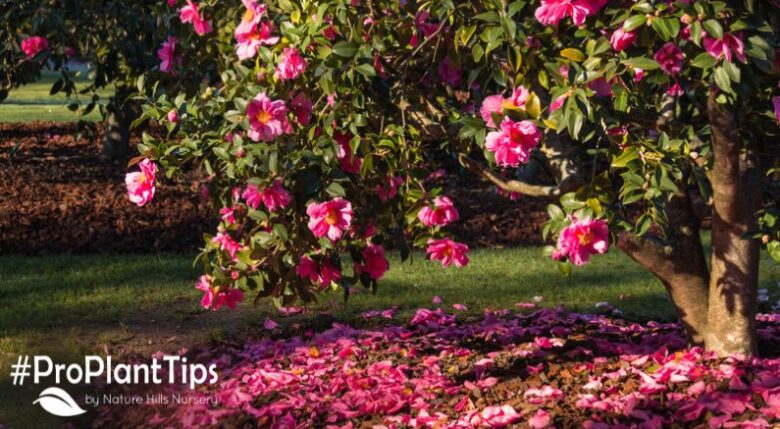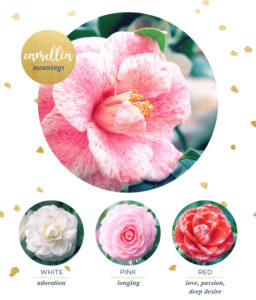Are you tired of bland and uninspired gardens? Looking to add a touch of elegance and grace to your outdoor space? Look no further than camellias, the stunning flowering plant that is taking over gardens across the world. In this article, we will explore the transformative power of camellias and how they can elevate your landscape in ways you never thought possible.
What Are Camellias?
Camellias are beautiful flowering plants that enhance the aesthetics of gardens. They are a part of the Theaceae family and originate from Asia. Known for their magnificent blossoms, camellias come in a variety of colors and shapes. These evergreen shrubs or small trees thrive in acidic soil and prefer partial shade. With appropriate care and attention, camellias can thrive and become the focal point of any garden.
Consider adding camellias to your landscape to create a striking showcase of color and sophistication.
The History of Camellias in Gardens
Camellias have a long and illustrious history in gardens, dating back centuries. Originating in China and later introduced to Japan, these beautiful flowers were highly prized for their beauty and symbolism. In the 18th century, they were brought to Europe and quickly gained popularity among the aristocracy. Today, camellias can be found in gardens all over the world, admired for their elegant blooms and graceful presence. If you’re considering incorporating camellias into your garden, try planting different varieties to create a stunning display of colors and shapes. And don’t forget to provide proper care and maintenance to ensure the longevity and health of these gorgeous flowers.
How to Incorporate Camellias into Your Garden
One of the most elegant and graceful additions to any garden is the camellia flower. With its wide range of colors and sizes, this beloved flower can transform any landscape into a stunning display. In this section, we will discuss how you can incorporate camellias into your own garden. We’ll start by exploring the different varieties of camellias and how to choose the right one for your climate. Then, we’ll cover the necessary steps for planting and caring for these beautiful flowers. Lastly, we’ll discuss how to design your garden with camellias in mind, creating a cohesive and eye-catching display.
1. Choosing the Right Variety for Your Climate
The key to successfully incorporating camellias into your garden is selecting the right variety for your specific climate. Follow these steps to ensure the best results:
- Research your local climate conditions and determine the hardiness zone of your area.
- Choose camellia varieties that are known to thrive in your particular hardiness zone.
- Take into account factors such as temperature extremes, rainfall, and humidity levels when selecting a variety.
- Consult with local nurseries or gardening experts for recommendations and advice.
- Ensure proper care and maintenance based on the specific needs of your chosen camellia variety.
By carefully choosing camellia varieties that are well-suited to your climate, you can enjoy the beauty and benefits of these stunning plants in your garden.
2. Planting and Caring for Camellias
Planting and caring for camellias involves a few essential steps to ensure their health and beauty in your garden.
- Choose the right location: Camellias prefer partial shade and well-drained soil.
- Prepare the soil: Dig a hole twice as wide and deep as the root ball, and mix in organic matter to improve drainage.
- Plant the camellia: Place the plant in the designated hole, ensuring that the top of the root ball is level with the soil surface. Backfill with soil and gently firm it around the plant.
- Water regularly: Keep the soil evenly moist, especially during dry periods. Avoid overwatering to prevent root rot.
- Apply mulch: Mulching helps retain moisture and suppress weeds. Spread a layer of organic mulch around the base of the plant.
- Prune as needed: Perform light pruning after the plant finishes blooming to maintain its shape and remove dead or damaged branches.
- Fertilize appropriately: Feed camellias with a balanced, slow-release fertilizer in spring and late summer to promote healthy growth and abundant blooms.
3. Designing with Camellias in Mind
Designing your garden with camellias in mind can bring a touch of elegance and harmony to your landscape. Follow these steps to create a beautiful camellia garden:
- Choose the perfect location: Camellias thrive in well-drained soil and prefer partial shade. Select an area that provides these ideal conditions.
- Create a focal point: Use camellias as the centerpiece of your garden design. Plant larger varieties as standalone specimens or incorporate them into a mixed planting scheme.
- Vary heights and sizes: Plant camellias of different heights and sizes to add visual interest and dimension to your garden. Combine tall varieties with shorter ones to create layers of color and texture.
- Consider bloom time: Select camellias with different bloom times to ensure a continuous display of flowers throughout the year. Combine early bloomers with late bloomers for a prolonged flowering season.
- Complement with other plants: Pair camellias with other plants that complement their colors and foliage. Consider using evergreen shrubs, ornamental grasses, or flowering perennials to create an attractive backdrop.
- Provide proper care: Regularly water and fertilize camellias to ensure healthy growth and abundant blooms. Mulch around the base of the plants to retain moisture and suppress weeds.
- Add hardscape elements: Incorporate hardscape elements like pathways, seating areas, or decorative structures to enhance the overall design and provide visual interest.
Designing your garden with camellias in mind will create a stunning and cohesive landscape that showcases the beauty of these elegant plants. Follow these steps to create a camellia-centric garden that will be the envy of all who see it.
The Beauty and Benefits of Camellias in Gardens
Camellias have long been revered for their elegant and graceful beauty, making them a beloved addition to gardens around the world. In this section, we will explore the various ways in which camellias enhance the aesthetic appeal of any landscape. From their stunning blooms in a variety of colors to their ability to attract pollinators and wildlife, camellias bring both beauty and benefits to any garden. Additionally, we will discuss their low maintenance nature and drought tolerance, making them a practical and sustainable choice for gardeners.
1. Stunning Blooms in a Variety of Colors
Camellias are highly sought-after for their stunning blooms, which come in a wide array of vibrant colors. To incorporate these gorgeous flowers into your garden, follow these simple steps:
- Choose the appropriate variety for your specific climate. Some camellias thrive in cooler regions, while others prefer warmer temperatures.
- Properly plant and care for your camellias. Ensure they have well-draining soil, partial shade, and regular watering.
- Design your garden with camellias in mind. Consider their growth habits and create a layout that showcases their vibrant beauty.
Not only do camellias enhance the visual appeal of your garden, but they also attract pollinators and wildlife. With their low maintenance needs and drought tolerance, camellias make a fantastic addition to any garden.
2. Attracts Pollinators and Wildlife
Camellias are not only visually stunning, but they also serve as a magnet for pollinators and wildlife in your garden, creating a thriving ecosystem. Here are some steps to incorporate camellias for this purpose:
- Choose native camellia varieties known for attracting pollinators and wildlife.
- Plant camellias in clusters or groups to provide a visually appealing habitat for pollinators.
- Include other plants and flowers that complement camellias and attract a diverse range of pollinators.
- Provide a water source, such as a birdbath or shallow dish, for birds and insects.
- Avoid using chemical pesticides or herbicides that can harm pollinators and wildlife.
I added camellias to my garden, and within a few weeks, I noticed an increase in the number of butterflies and bees visiting. The vibrant blooms attracted them, and it was a joy to see the garden buzzing with life. The camellias not only added beauty to my space but also played a vital role in supporting local pollinators and wildlife.
3. Low Maintenance and Drought Tolerant
Camellias are not only beautiful but also require low maintenance and are drought tolerant, making them an ideal addition to any garden. Here are some steps to incorporate camellias into your garden:
- Choose the right variety for your climate. Camellias thrive in different climates, so be sure to select a variety that is well-suited to your region.
- Plant and care for camellias correctly. Provide well-drained soil, partial shade, and regular watering during the establishment period to ensure their health and growth.
- Design your garden with camellias in mind. Consider their size and growth habit when planning their placement and companion plants, to ensure a harmonious and visually appealing garden.
With their stunning blooms, ability to attract pollinators, and low water requirements, camellias are an excellent choice for a low maintenance and drought tolerant garden.
Common Issues and Solutions for Growing Camellias
When it comes to growing camellias in your garden, there are a few common issues that you may encounter. However, with the right knowledge and techniques, these issues can easily be solved. In this section, we will discuss the various pests and diseases that can affect camellias and how to combat them. We will also explore the importance of proper pruning and shaping for healthy camellia plants. Lastly, we will delve into the specific soil and fertilizer needs of camellias to ensure their growth and beauty in your garden.
1. Pests and Diseases
Pests and diseases can be challenging to deal with when growing camellias, but with proper care and attention, these issues can be effectively managed. Here are some steps to address common pest and disease problems:
- Regular inspection: It is important to regularly check your camellias for any signs of pests or diseases, such as distorted leaves or discoloration.
- Early intervention: If you notice any issues, it is crucial to take immediate action to prevent further damage. This may involve removing affected leaves or using organic pest control methods.
- Proper watering: To avoid creating conditions favorable for disease development, it is important to avoid overwatering. Instead, water at the base of the plant to keep the foliage dry.
True story: A gardener noticed their camellias being infested with aphids. In response, they introduced ladybugs, natural predators of aphids, to their garden. Within a few weeks, the ladybugs successfully reduced the aphid population, allowing the camellias to thrive.
2. Pruning and Shaping
Pruning and shaping camellias is essential for keeping them healthy and enhancing their appearance in your garden. Follow these steps for successful pruning and shaping:
- Choose the right time: Prune after the blooming period in late spring or early summer.
- Remove dead or diseased branches: Cut them back to healthy wood to prevent the spread of diseases.
- Thin out crowded branches: Remove any crossing or overcrowded branches to improve air circulation and sunlight penetration.
- Maintain a balanced shape: Prune to maintain a natural, rounded form, keeping the center open to prevent disease and promote healthy growth.
- Use sharp and clean tools: Ensure your pruning shears are sharp and disinfected to prevent the spread of diseases.
A passionate gardener diligently pruned and shaped her camellias every year. The result was a stunning display of vibrant blooms and a healthy, well-maintained garden that drew admiration from neighbors and passersby. Her dedication to pruning and shaping transformed her garden into a captivating oasis of beauty and elegance.
3. Soil and Fertilizer Needs
To ensure that your camellias have the right soil and fertilizer conditions, follow these steps:
- Test the soil: Conduct a soil test to determine the pH level and nutrient content. Camellias thrive in slightly acidic soil with a pH range of 5.5 to 6.5.
- Amend the soil: If the pH is too high, add elemental sulfur or acidic organic matter, such as peat moss, to lower it. If the pH is too low, add lime to raise it. Incorporate compost or well-rotted manure to improve soil structure and fertility.
- Fertilize regularly: Apply a slow-release balanced fertilizer specifically formulated for acid-loving plants in early spring. Repeat applications during the growing season according to package instructions. Avoid excessive fertilization, as it can damage camellias.
- Mulch: To conserve moisture, suppress weeds, and provide nutrients as it breaks down, apply a layer of organic mulch, such as pine straw or bark chips, around the base of the plants.
- Water appropriately: Keep the soil consistently moist but not waterlogged. Water deeply and infrequently to encourage deep root growth.
By following these steps, you can provide the necessary soil and fertilizer conditions for your camellias to thrive and stay healthy.
Transforming Your Garden with the Elegance and Grace of Camellias
Transforming your garden with the elegance and grace of camellias can create a stunning landscape that is both visually pleasing and inviting. Camellias are known for their beautiful blooms, which come in a variety of colors and sizes. Their glossy evergreen leaves also provide year-round interest. To incorporate camellias into your garden, consider the following:
- Choose the right location: Camellias thrive in partial shade and prefer well-draining soil.
- Select the right variety: There are different types of camellias, including japonicas, sasanquas, and hybrids. Research the characteristics of each to find the best fit for your garden.
- Provide proper care: Camellias require regular watering, mulching, and occasional pruning to maintain their health and shape.
Fact: Did you know that camellias have been grown in gardens for centuries and are often associated with beauty, love, and admiration?
Frequently Asked Questions
What are camellias and what makes them special for gardens?
Camellias are flowering plants that come in a wide variety of colors and sizes. They are special for gardens because of their elegant and graceful appearance, as well as their easy maintenance and ability to thrive in different climates.
How can camellias transform a garden’s landscape?
Camellias can transform a garden’s landscape by adding a touch of elegance and grace through their beautiful blooms. They can also provide structure and depth to the overall design, creating a stunning visual impact.
What are the different types of camellias that can be grown in gardens?
There are many types of camellias that can be grown in gardens, including Japonica, Sasanqua, and Reticulata. Each variety has its own unique characteristics, such as flower shape, color, and size, allowing for a diverse and beautiful garden display.
Do camellias require a lot of maintenance?
No, camellias are relatively low maintenance plants. They require well-drained soil, regular watering, and occasional pruning to maintain their shape. However, they are generally hardy and can thrive with minimal care.
Can camellias be grown in any climate?
Camellias can be grown in a wide range of climates, as long as the conditions are suitable for their growth. They prefer temperate climates with mild winters and moderate humidity, but some varieties can also tolerate colder temperatures.
What are some popular landscaping ideas for incorporating camellias?
Some popular landscaping ideas for incorporating camellias include creating a colorful hedge, using them as focal points in a garden bed, or planting them in containers for a patio or balcony. They can also be used to create a stunning backdrop for other plants or as part of a traditional Japanese garden design.



